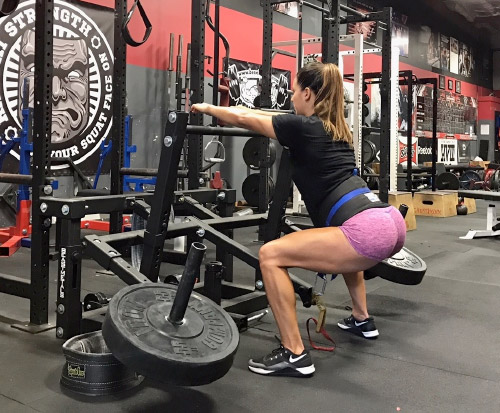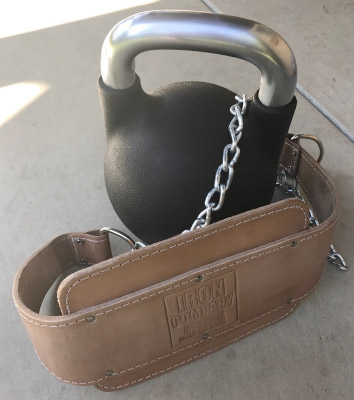
Forgotten Exercises: The Belt Squat
Featured Weightlifting Equipment: belt squat machine, barbell, leg press machine, hack squat machine, leg extension machine, dumbbells, weight plates, dipping belt, kettlebell, squat rack, suspension training straps
The belt squat machine is an incredibly effective, insanely difficult leg exercise that delivers all the results of barbell squatting (the undisputed King) of all progressive resistance exercises. The advantage of the belt squat is it delivers the result without having to have a barbell on your shoulders. Many athletes cannot back squat because of previous spinal or back injuries. The belt squat offers a way in which those that cannot back squat an equally effective alternative.
Until you have experienced belt squatting, words cannot adequately convey the exercise and the depth of inroad it creates. The belt squat was far more popular forty years ago than it is now. Lifters stopped doing belt squats with the widespread introduction of progressive resistance machines, particularly leg training machines. Belt squatting is awkward; getting into position is tricky and slightly dangerous as it is a struggle to maintain balance during a belt squat set.
A leg press machine, a hack squat machine, a leg extension machine, all are thigh exercises done on machines and if results were equal machines would be the way to go: a leg exercise machine are far easier to use, far safer and a lot more fun; machines have smooth, calibrated rep strokes. Unfortunately, when compared to the free-weight exercises they mimic, results are not equal: progressive resistance exercises, done on a machine, are demonstratively inferior.
In progressive resistance training, easier and smoother are not optimal for results: machines are optimal for ease insofar as ease of use and inferior for creating maximal muscular inroad. Crude, awkward and difficult trump smooth and easy every single time – if the goal is tangible, measurable results. How do we define resistance training results? More muscle, more strength, more power. Crude tools and implements dig deeper muscular inroads than ball-bearing smooth machine training. Machines eliminate the 3rd dimension of tension, the need to control side to side movement during an exercise.
With any machine you can dedicate 100% of your available strength to pushing or pulling: no need to allot any strength towards controlling side-to-side movement. The machine motor pathway is locked in. Muscle stabilizers stay inert during machine reps: muscle stabilizers go bat-shit crazy when lifting a pair of dumbbells or a barbell. Muscle stabilizers go even more crazy when subjected to a session of Old School belt squats. Machines are maximally stable whereas belt squatting is maximally unstable. When it comes to muscle-building and strength-infusing, instability trumps stability every single time. The very characteristic that makes machine training attractive, ease of use, is factually the machines Achilles heel.
A belt squat platform is two raised foot rests separated by an open space. The raised platform with the open space between the feet allows the belt squatter (a weightlifting belt with a chain to which plates can be attached) to drop to below parallel without the plates hitting the floor. If the platform is sturdy enough and high enough, the belt squatter can dip all the way down, ass-on-heels, and not have the dangling plates hanging at the end of a chain hit the floor.
If you are lucky enough to have access to a belt squat platform, you have access to a tool that can take your thigh size and thigh power to unimaginable heights. Use belt squats in conjunction with barbell back squats and front squats and you have all the leg exercises you will ever need. Most belt squat platforms have a vertical pole for the squatter to hang onto. As anyone that has ever done a reasonably heavy set of belt squats can attest to, a load of weight plates dangling at the end of the chains has a mind of its own: as the squatter squats the Olympic plates will swing back and forth. This creates the ultimate in instability and the ultimate in muscle stabilizer activation.

For those not blessed with access to a belt squat machine, try using a dipping belt and a kettlebell. Run the chain through the handle and adjust the length so that the handle remains as close to the crotch as possible as you squat. This will give you the greatest range of motion and will allow you to go parallel (or below) for maximal results. For additional stability, hold on to a squat rack or a pair of suspension training straps.
The thigh pump created by technically perfect belt squat reps is absolutely devastating in the best possible way. The exercise is pure thigh muscle. The degree of thigh isolation surpasses even squats, the eternal leg power benchmark.
About the Author
As an athlete Marty Gallagher is a national and world champion in Olympic lifting and powerlifting. He was a world champion team coach in 1991 and coached Black's Gym to five national team titles. He's also coached some of the strongest men on the planet including Kirk Karwoski when he completed his world record 1,003 lb. squat. Today he teaches the US Secret Service and Tier 1 Spec Ops on how to maximize their strength in minimal time. As a writer since 1978 he’s written for Powerlifting USA, Milo, Flex Magazine, Muscle & Fitness, Prime Fitness, Washington Post, Dragon Door and now IRON COMPANY. He’s also the author of numerous books including Purposeful Primitive, Strong Medicine, Ed Coan’s book “Coan, The Man, the Myth, the Method" and numerous others. Read the Marty Gallagher biography here.

